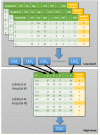Pediatric readmission classification using stacked regularized logistic regression models
- PMID: 25954417
- PMCID: PMC4419883
Pediatric readmission classification using stacked regularized logistic regression models
Abstract
Background: Regulations and privacy concerns often hinder exchange of healthcare data between hospitals or other healthcare providers. Sharing predictive models built on original data and averaging their results offers an alternative to more efficient prediction of outcomes on new cases. Although one can choose from many techniques to combine outputs from different predictive models, it is difficult to find studies that try to interpret the results obtained from ensemble-learning methods.
Methods: We propose a novel approach to classification based on models from different hospitals that allows a high level of performance along with comprehensibility of obtained results. Our approach is based on regularized sparse regression models in two hierarchical levels and exploits the interpretability of obtained regression coefficients to rank the contribution of hospitals in terms of outcome prediction.
Results: The proposed approach was used to predict the 30-days all-cause readmissions for pediatric patients in 54 Californian hospitals. Using repeated holdout evaluation, including more than 60,000 hospital discharge records, we compared the proposed approach to alternative approaches. The performance of two-level classification model was measured using the Area Under the ROC Curve (AUC) with an additional evaluation that uncovered the importance and contribution of each single data source (i.e. hospital) to the final result. The results for the best distributed model (AUC=0.787, 95% CI: 0.780-0.794) demonstrate no significant difference in terms of AUC performance when compared to a single elastic net model built on all available data (AUC=0.789, 95% CI: 0.781-0.796).
Conclusions: This paper presents a novel approach to improved classification with shared predictive models for environments where centralized collection of data is not possible. The significant improvements in classification performance and interpretability of results demonstrate the effectiveness of our approach.
Figures



Similar articles
-
Building interpretable predictive models for pediatric hospital readmission using Tree-Lasso logistic regression.Artif Intell Med. 2016 Sep;72:12-21. doi: 10.1016/j.artmed.2016.07.003. Epub 2016 Jul 29. Artif Intell Med. 2016. PMID: 27664505
-
Casting a Wider Net: Data Driven Discovery of Proxies for Target Diagnoses.AMIA Annu Symp Proc. 2015 Nov 5;2015:1047-56. eCollection 2015. AMIA Annu Symp Proc. 2015. PMID: 26958243 Free PMC article.
-
Predicting 30-day Hospital Readmission with Publicly Available Administrative Database. A Conditional Logistic Regression Modeling Approach.Methods Inf Med. 2015;54(6):560-7. doi: 10.3414/ME14-02-0017. Epub 2015 Nov 9. Methods Inf Med. 2015. PMID: 26548400
-
Predictive models for hospital readmission risk: A systematic review of methods.Comput Methods Programs Biomed. 2018 Oct;164:49-64. doi: 10.1016/j.cmpb.2018.06.006. Epub 2018 Jun 28. Comput Methods Programs Biomed. 2018. PMID: 30195431
-
Predictive Modeling of Hospital Readmission: Challenges and Solutions.IEEE/ACM Trans Comput Biol Bioinform. 2022 Sep-Oct;19(5):2975-2995. doi: 10.1109/TCBB.2021.3089682. Epub 2022 Oct 10. IEEE/ACM Trans Comput Biol Bioinform. 2022. PMID: 34133285
Cited by
-
Comprehensible Predictive Modeling Using Regularized Logistic Regression and Comorbidity Based Features.PLoS One. 2015 Dec 8;10(12):e0144439. doi: 10.1371/journal.pone.0144439. eCollection 2015. PLoS One. 2015. PMID: 26645087 Free PMC article.
-
Applicability of predictive models for 30-day unplanned hospital readmission risk in paediatrics: a systematic review.BMJ Open. 2022 Mar 30;12(3):e055956. doi: 10.1136/bmjopen-2021-055956. BMJ Open. 2022. PMID: 35354615 Free PMC article.
-
Are Randomized Controlled Trials the (G)old Standard? From Clinical Intelligence to Prescriptive Analytics.J Med Internet Res. 2016 Jul 6;18(7):e185. doi: 10.2196/jmir.5549. J Med Internet Res. 2016. PMID: 27383622 Free PMC article.
-
Identifying the Prevalence and Causes of 30-Day Hospital Readmission in Children: A Case Study from a Tertiary Pediatric Hospital.Glob J Qual Saf Healthc. 2023 Nov 24;6(4):101-110. doi: 10.36401/JQSH-23-17. eCollection 2023 Nov. Glob J Qual Saf Healthc. 2023. PMID: 38404457 Free PMC article.
-
A non-negative spike-and-slab lasso generalized linear stacking prediction modeling method for high-dimensional omics data.BMC Bioinformatics. 2024 Mar 20;25(1):119. doi: 10.1186/s12859-024-05741-6. BMC Bioinformatics. 2024. PMID: 38509499 Free PMC article.
References
-
- Coloma PM, Schuemie MJ, Trifirò G, et al. Combining electronic healthcare databases in Europe to allow for large-scale drug safety monitoring: the EU-ADR Project. Pharmacoepidemiology and drug safety. 2011;20(1):1–11. - PubMed
-
- Davis DA, Chawla NV, Christakis NA, Barabási AL. Time to CARE: a collaborative engine for practical disease prediction. Data Mining and Knowledge Discovery. 2010;20(3):388–415.
Publication types
MeSH terms
LinkOut - more resources
Full Text Sources
